How to reach here:
By Air: Srinagar domestic airport is connected with many airports of the major cities in India. Regular flights are operated between Srinagar and Delhi, Mumbai, Chandigarh and Shimla.
By Rail: Jammu is the nearest railway station to Srinagar, which is at a distance of 290 km. Jammu railway station is well connected to all major cities in India by rail.Taxi services are available from Jammu to Srinagar.
Best time to visit: April to October.
Languages spoken: Kashmiri, Urdu, Hindi, English.
Must eat: Rogan Josh (lamb cooked in spicy red gravy), Yakhni (lamb cooked in curd based gravy),Syoon Pulaav (Meat Pulao), must try -Wazwan (a multi-course meal), Kahwah
Famous Restaurants: Ahdoos, Stream, Shamyana, Lhasa , Mughal darbar.
Places you must visit:
Popularly known as 'Srinagar's jewel' the Dal Lake, spread over a straggling 26 sq.km, is the most popular tourist attraction in Srinagar. Renowned for its house boats and Shikara boat rides, set against the slow clad glorious Himalayas, the Dal Lake continues to be on the canvas & subject of several poets & artists. Its unparalleled beauty & scenic environs makes it ideal to stay aboard the luxury houseboats & enjoy the gleaming evening sun shimmering on the lake as it goes down. The lake is partitioned in to four areas by four causeways, with the Western part of the lake dotted with many Islands attracting tourists with its serenity and solitude.
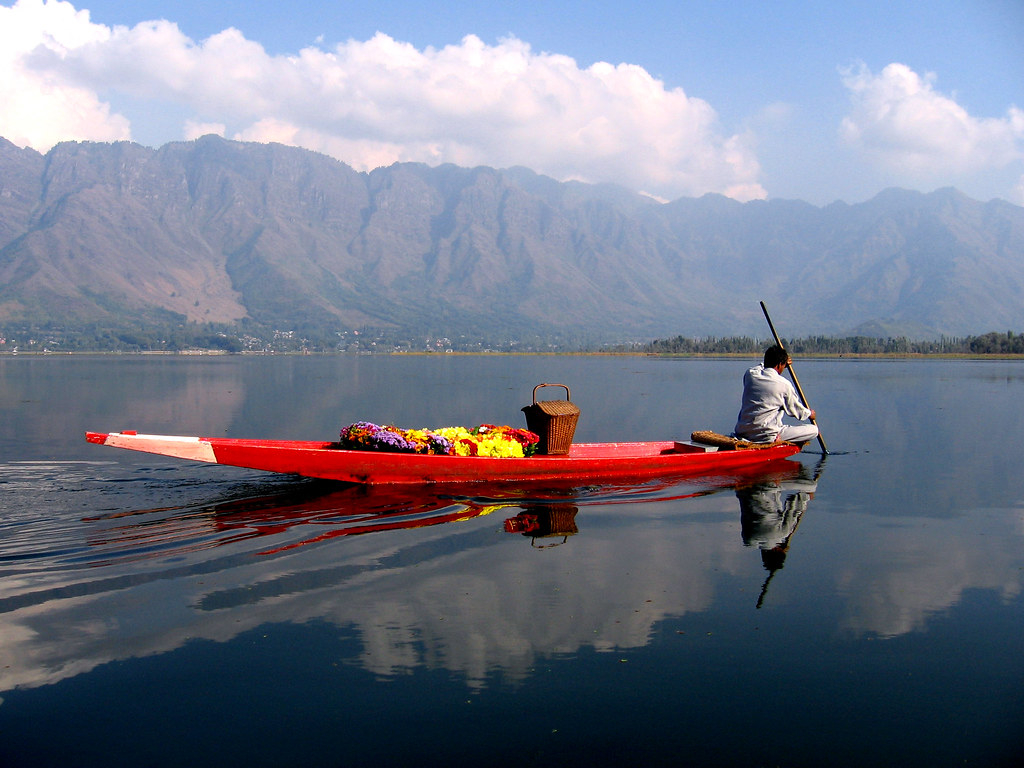
Mughal Gardens, as the name suggests, built in the Mughal period is a marvel.These gardens are a fine example of the Mughal style of architecture & design. The Mughal Gardens is combination of three renowned gardens namely the Nishat Bagh, Shalimar Gardens and Chashm-e-shahi. These gardens are every travelers delight with beautifully laid out manicured gardens, with vibrant flowerbeds, terraced lawns and well long stretches of cascading fountains.

Nishat Bagh, meaning the 'The garden of joy' located on the eastern side of the Dal Lake is a marvelous garden designed by Asaf Khan, Nur Jahan's brother. Laid out in 1633 it is among the largest of the Mughal Gardens. The garden with rare species of flowering plants and long avenues of chinar & cypress trees, has 12 terraces out of which the second terrace is considered the most impressive with 23 niches provided in its arched recess, just behind the cascade.This garden placed on the banks of the beautiful Dal Lake in the backdrop of the amazing the Zabarwan hills, is complete with fountains, flower beds and impressive lawns.
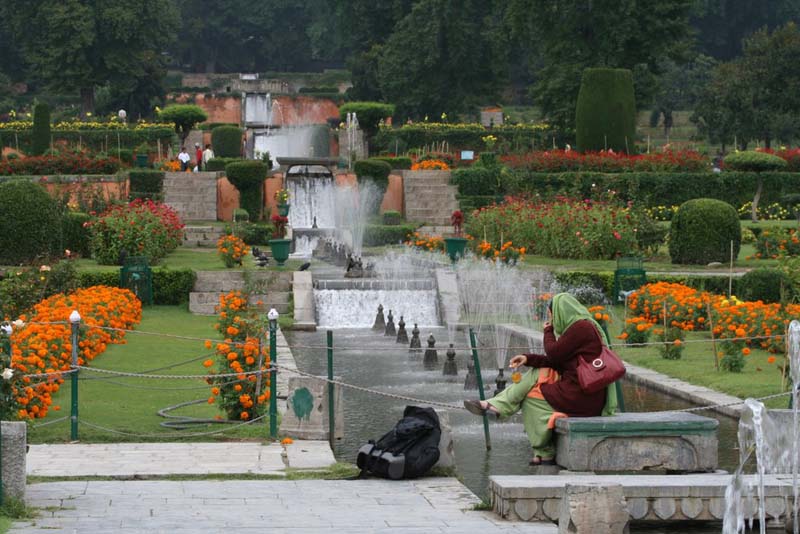
Shalimar Gardens was constructed by the great Mughal Emperor Jahangir in 1616 for his beloved wife Nurjahan, the sprawling garden with four terraces, imposing fountains, well laid out manicured gardens, tall trees & fresh mountain air is one of the must visit places while in Srinagar.The Mughal Gardens layout taken from the Persian gardens has three terraces with fountains & lined with Chinar trees. Each of the 3 terraces carried distinct importance, the first one being the public terrace; called the Diwan-e-Aam. The second terrace called the Diwan-e-Khas was accessible only to nobles or guests of the court. And the third & the highest terrace called as “Abode of Love" was reserved for the king and the royal ladies.

Chashme Shahi Garden, founded in 1632 with a length of 108 meters and breadth of 38 meters, is a small beautiful garden, the smallest among the famous Mughal gardens. This garden, also known as Royal Spring, is located near the Nehru Memorial Park in Srinagar. The garden is established in three sections with an aqueduct with fountains and waterfalls located along the middle. Different varieties of beautiful fragrant flowers and manicured lawns are the main attractions in this garden.It is believed that the fresh water spring in the garden has medicinal value. The garden provides splendid views of verdant greens, majestic mountain ranges and views of the Dal Lake. Pari Mahal and Char Chinar are few nearby attractions that are worth visiting.

Nagin Lake got its name from the trees surrounding the lake. Popularly known as the 'Jewel in the Ring’, it is one of the impressive lakes in east Srinagar.The lake with its deep blue waters is separated from the Dal Lake by a thin causeway and is an exciting tourist spot with number of houseboats dwindling in the calm waters.Nagin Lake is a perfect place to go for swimming as it is less crowded and deeper. Water Skiing & sailing on fiberglass boats can also be enjoyed here.

Wular Lake, the largest fresh-water lake in India, serves as a natural reservoir by drawing the excess water from the River Jhelum. Remains of a wonderful island built by King Zain-ul-abidin can be seen in the midst of the lake. Situated between the towns of Bandipore and Sopore, this unexplored and untouched lake is home to several species of birds. Many streams namely - Pohru, Harbuji, Erin and the Aarah, flow into the vast Wullar Lake.
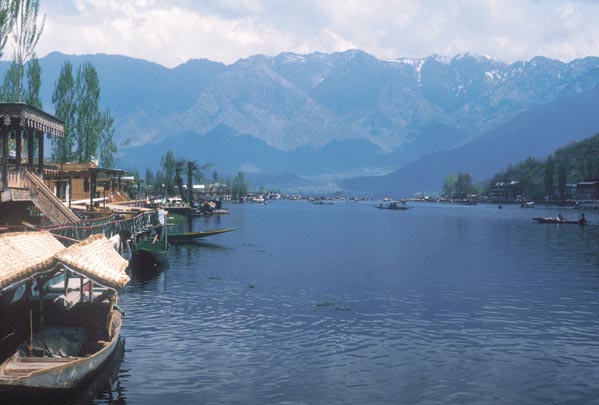
Pari Mahal (House of Fairies) also known as Quntilon, is a historic monument placed above the beautiful Chashma Shahi Gardens near Srinagar. The ancient monument brings out the architectural brilliance of the fore gone age. A well-laid spacious garden surrounds this structure, which was once a Buddhist monastery and later served as a school of astrology promoted by the eldest son of Shah Jahan, Dara Shikoh. The garden, in the lawn of Pari Mahal with a small spring in the middle, with blooming flowers and fruits overlooks the picturesque Dal Lake.

Pratap Singh Museum, erstwhile summer palace of Kashmir Kings, is a historically important museum in Srinagar established in 1898. Located in Lal Mandi, on the left bank of the river Jhelum, the museum has valuable ancient terracotta heads of the 3rd century found at the Buddhist site at Ushkur and molded terracotta plaques of 4th & 5th century from Harwan.An ancient brass model of Lokeshvara, copper image of Lord Buddha in 5th century Gandhara-style and the green stone structures of Lord Vishnu sitting on Garuda are added attractions here.Other items on display include shawls, arms & armory, paintings, ancient coins and Ladakhi handicrafts.

Shankaracharya Temple, known to be built by Jaluka, the son of Emperor Ashoka around 200 BC, is an ancient shrine located on the Shankaracharya Hill (Takht-e-Suleiman) in Srinagar. This sacred site, situated at a height of about 1100 feet on the south-east of the city, offers splendid views of the valley and the snow clad mountains of the Pir Panjal range. Local folks tell a story that saint Shankaracharya spent some of his time at this site during his visit to Kashmir to revitalize Sanatan Dharma. Shankaracharya Temple, constructed on an elevated octagonal plane, can be reached through a flight of steps bounded by side-walls. The inner sanctum adorns a modern ceiling & several Persian inscriptions.
Jyeshtheswara Temple in Srinagar has several myths and beliefs associated with it. According to a popular belief, this temple was constructed by the Pandavas, important figures of the great Indian epic, the Mahabharata, in 5th century. Others believe that it was built by the Emperor Gopaditya during the 6th century. Some researchers, however, are of the opinion that Jaluka, the son of Emperor Ashoka had the temple constructed. The temple has undergone renovations numerous times and was last revamped during 8th century by the King Lalitaditya Muktapida.

A relatively calm & peaceful mosque, the Dastgir Sahib dargah is situated in old part of Srinagar city. Communal harmony and syncretism have been the features of this mosque for many centuries. The delicate white & green exteriors & glorious interiors covered with 'Papier-Mache' scroll work, Arabic scriptures & floral motifs make this mosque a beautiful place to visit. The intricately carved panels & the Aytal Kursi which hang at the door are the highlights of this mosque.
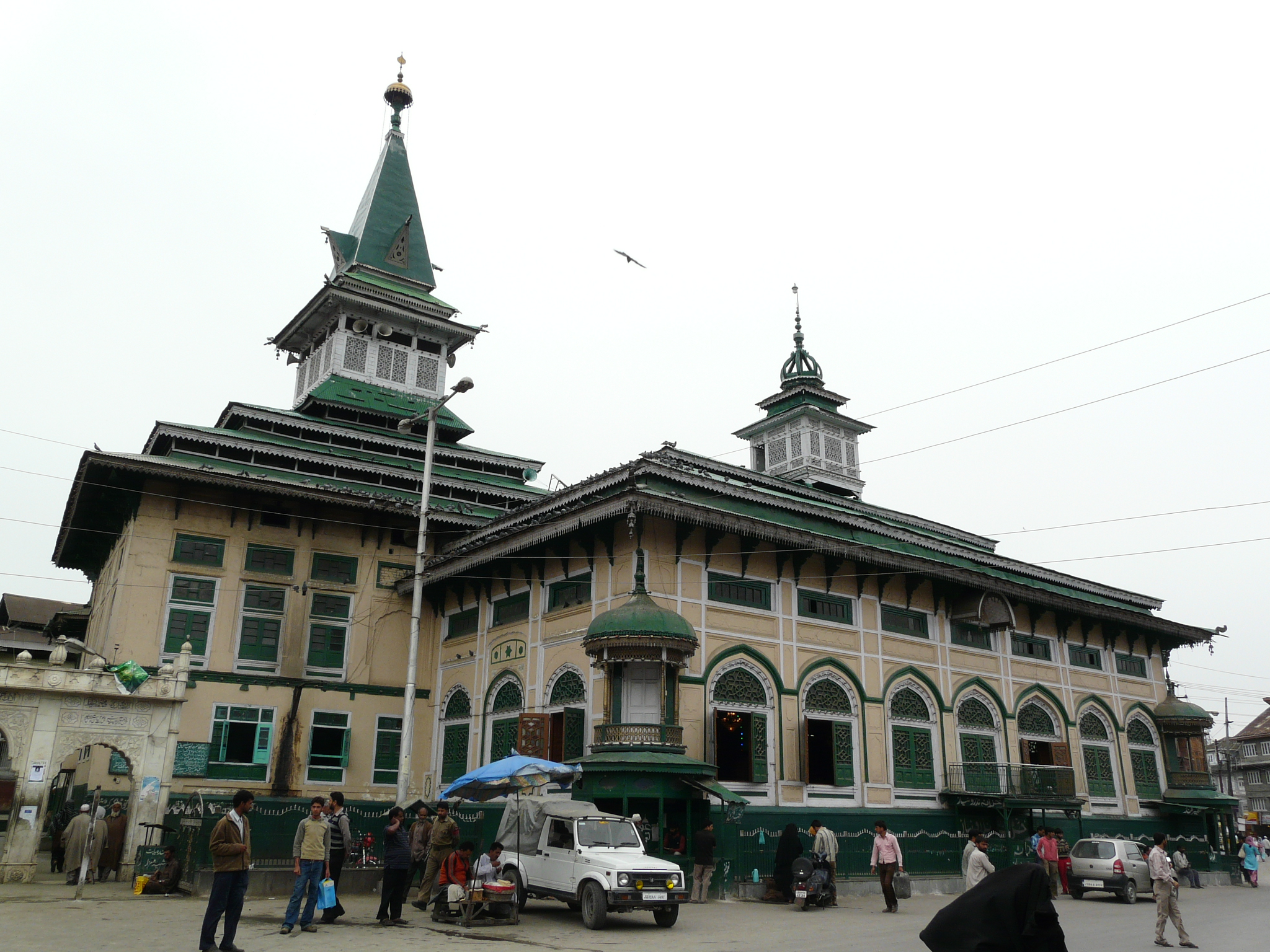
Hazratbal Mosque also known as Dargah Sharif, Assar-e-Sharif and Madinat-Us-Sani is situated on the western banks of the majestic Dal Lake. With the impressive Nishat Bagh in the vicinity, this enchanting white marble mosque offers great views of the Lake in the back drop of the majestic Himalayas.The Mosque is a combination of Kashmiri and Mughal styles of architecture, with historical significance dating back to the 17th century. The distinctiveness of the Hazratbal Mosque is that it enshrines the 'Moi-e-Muqaddas' (the sacred hair) of the prophet Mohammed, which is shown to public only on special occasions.
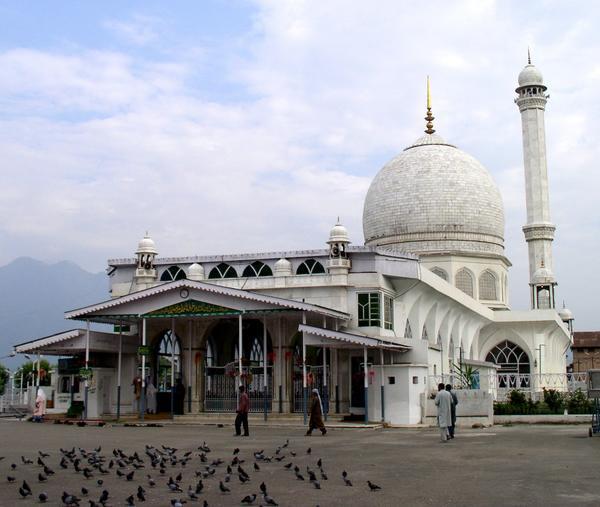
Jamia Masjid,an ancient mosque, which was destroyed and restored several times over the centuries is a fine example of Indo-Saracenic architecture.The present mosque, an impressive building without an opped dome, was built in 1674. Situated at Nowhatta, in the middle of the old city, the mosque’s main attraction is the prayer hall, which contains 370 wooden pillars; each one made with a single piece of deodar trunk. The compound is constructed in the style of a Mughal Garden, with two wide paths. This spacious mosque can accommodate 30,000 people at one time during prayers.

Khanqah-e-Moulla, also called the shrine of Shah-e-Hamdan and Shah-i-Hamdan Mosque, is popular as it was the first ever mosque constructed in Kashmir. Built on the beautiful sandy banks of the Jhelum river in Srinagar, Sultan Sikander built this around 1400 AD in honor of Mir Syed Ali Hamdani, the Muslim saint who popularized Islam in Kashmir.Devotees throng to this shrine on the sixth day of Dul-Haj (the last month of the Islamic Lunar calendar Dul-Haj), on the death anniversary of Mir Syed Ali Hamdani. The shrine bears a wooden structure with marvelously carved roofs, & rich interiors carved with ancient religious sermons and historical inscriptions.

Burzahom holds archaeological importance and is situated to the north-west of Shalimar Gardens. It is the first Neolithic site that was exposed in the state of Jammu and Kashmir. The word Burzahom means 'place of birth' in the local language and is known to have ancient artefacts dating back to more than 5,000 years. The main archaeological materials collected from this site are animal skeletons, tools, pots, tools, arrowheads and implements of Neolithic age.It was excavated for about six seasons from 1961 to 1968, which yielded 10 human skeletons. These human skeletons were of several cultural stages including Neolithic, Neolithic-Megalithic and some other early historic cultures.

RozaBal Shrine is being claimed by both Muslims and Christians. Muslims believe that this shrine is a tomb of a saint named Yuz Asaf, whereas several researchers believe that this Shrine has the holy body of Jesus Christ. This shrine is also known as Ziarati Hazrati Youza Asouph, which is still under controversy between Muslims and Christians.Recent claims state that this tomb belongs to Jesus Christ, who survived the crucifixion wounds and came to this place. His body has been buried as per the Jewish traditions and not according to the Islamic tradition. Natives also believe that this building has a burial tomb of a local Muslim saint, named Mir Sayyid Naseeruddin, who was buried according to the Islamic traditions. This tomb is currently maintained by a Board of Directors including Sunni Muslims.
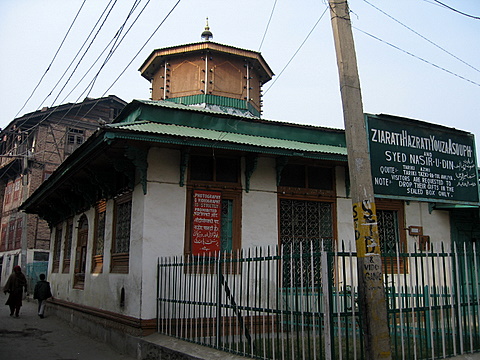
Harwan Gardens is a large picnic spot, which houses a canal, flowerbeds and chinar trees. There are big grassy lawns at this garden, where tourists can enjoy nature walk. This garden is considered to be the starting point of Mahadev Mountain trek and is an ideal gateway to Dachigam Wildlife Sanctuary.This garden does not have any central canal fountains or terraces and is known for its natural beauty. The canal inside this garden is called as Sarband, which is one of the old drinking water reservoirs that get water from the Dachigam Nallah.

Nasim Bagh or the Garden of Breezes is situated to the west of the Dal Lake. This bagh is one of the popular Mughal Gardens in the region, which has huge lawns and camping facilities for the visitors. The bagh is located on the banks of Jhelum River and is known for lakes and houseboats. Travellers can also find dry fruits and traditional Kashmiri handicrafts at this site.In 1586, this garden was constructed by the famous Mughal Emperor Akbar and it gives a beautiful view of Dal Lake. The Mughal Emperor Shah Jahan planted more than 1,200 trees in the garden in 1635.

Tomb of Madin Sahib is a unique tomb, which was built in the memory of Saint Madin Sahib. This tomb is located towards the north of Madin Sahib Mosque in Zadibal. It has the 15th century Kashmiri architectural style with the exterior walls ornamented with tiles.

Hari Parbat Fort is situated to the western side of the Dal Lake, which is an ancient Mughal Fort. This fort was built in 18th century by Atta Muhammad Khan, an Afghan governor. The surrounding walls of this fort were constructed by the Mughal Emperor Akbar in 1590. This place is currently maintained by the Archaeological Department of Jammu and Kashmir.

Kathi Darwaza is one of the two gates of the Hari Parbat Fort or the Mughal Fort, which is situated near the Dal Lake. The second gate is known as Sangin Darwaza and Kathi Darwaza is the main entrance to the fort. It has a domed chamber in the centre along with two recesses on either side. Visitors can also see few Persian commemorative inscriptions on the walls and ceilings of this gate.All these inscriptions are related to the Persian beliefs and culture that was practised by the Mughal rulers.

Sangeen Darwaza is the second entrance gate of the Hari Parbat Fort and does not have any inscriptions like Kathi Darwaza. This entrance gate has been constructed using stone and brick masonry.

Makhdum Sahib Shrine is located to the south of Hari Parbat Hill, which is mainly a double storey mosque. It has been built in the name of Sufi Saint Makhdum Sahib or Hazrat Sultan. It is situated below the Hari Parbat Fort and has been constructed as per the archaeological values and ancient culture of the Mughals.
Masjid of Akhund Mullah is a mosque within a mosque that has the main sanctuary in a courtyard. It is a small mosque which was constructed by Dara Shikoh, son of Shah Jahan, for honouring his tutor Akhun Mulla Shah. This mosque is located below the Makhdum Sahib Mosque and has been built using grey limestone.It also has a stone lotus erected on the top of the podium, which has an inscription that dates back to 1649. There is a specially constructed prayer chamber inside this mosque that attracts number of devotees.
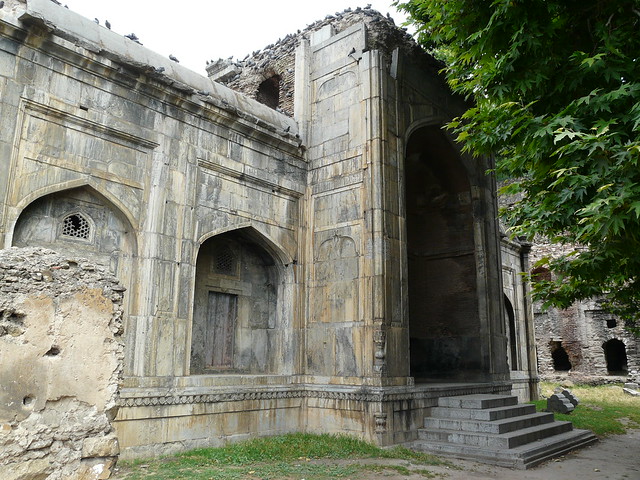
Indira Gandhi Tulip Garden is situated at the foothills of Zabarwan Mountains, which is near the banks of Dal Lake.It is one of the spacious gardens in Srinagar and is known to have more than 70 varieties of coloured tulip flowers.The garden covers approximately 90 acres of land and houses 1.3 million tulip bulbs that overlook the Dal Lake. It is situated in vicinity of Shalimar Garden, Nishat Garden, Chashm-e-Shahi Gardens and other Mughal Gardens.

Imambara Hassanabad is one of the oldest shrines in the region, which is worshipped by over one million Shia Muslims.There is also a Mughal graveyard named, 'Baba Mazar' situated near this shrine.This graveyard was the resting place of people like Syed Mirza Shah, Baba Ali and Hab Saheb Mulla. There are around five main entry points to this shrine that are constructed specially for women followers. This shrine was constructed in 1857 in a shape of octagon. The architectural style of this shrine has been influenced by the Indo-Iranian construction skills.

Charar-i-Sharif is a holy shrine which is more than 600 years old and is commonly known as Hazrat Sheikh Noor-ud-Din Wali. It was built for commemorating Sheikh Noor-ud-Din Noorani, who was a Sufi Muslim saint. The saint was born in 1377 and was called as Nund Rishi, who was a spiritual heir of a female saint, named Lal Ded.
Manasbal Lake is surrounded by villages like Jarokbal, Gratbal and Kondabal. It is regarded as one of the supreme gems of all Kashmir lakes, which is full of lotus. July and August is considered to be the ideal time to enjoy water skiing in the deep water of the lake.

Dachigam Wildlife Sanctuary is one of the most beautiful tourist attractions renowned for offering natural habitat to rare Kashmir stag Hangul and black and brown bears. Surrounded by mountains and beautiful flora, the sanctuary sprawls across an area of around 141 sq. km. Situated at an average altitude ranging from 5,500 to 14,000 ft above sea level, the sanctuary was declared as a National Park in 1951.Being a home to flora and fauna of the Himalayan range, the national park is divided into two sectors of Dachigam, including the lower and the upper Dachigam. A wide variety of vegetation is present in the sanctuary including grassland, rain forest, coniferous forest and broad leaved woodland. Dotted with bare rock faces and alpine pastures, the national park is a home to the most endangered species of red deer (Hangul).

nice pics n informative article
ReplyDelete